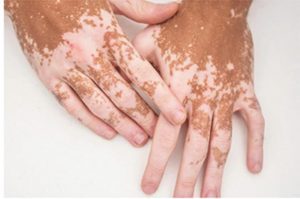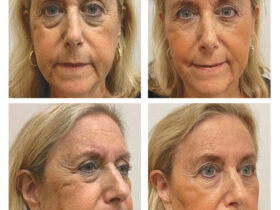By Christina Tremblay, PA-C
 Vitiligo is an autoimmune skin condition that causes your skin to lose its color or pigment. This condition happens when the body’s immune system destroys melanocytes. Melanocytes are skin cells that make melanin, which is the chemical that gives skin its color or pigmentation. When someone has vitiligo, they develop milky-white patches on their skin. This condition is more noticeable in people with darker skin because of the contrast between normal skin tone and the white patches that develop with vitiligo.
Vitiligo is an autoimmune skin condition that causes your skin to lose its color or pigment. This condition happens when the body’s immune system destroys melanocytes. Melanocytes are skin cells that make melanin, which is the chemical that gives skin its color or pigmentation. When someone has vitiligo, they develop milky-white patches on their skin. This condition is more noticeable in people with darker skin because of the contrast between normal skin tone and the white patches that develop with vitiligo.
Anyone can get vitiligo and it can occur at any age. Michael Jackson is famously known for having this condition. For many people, the white patches start to appear before the age of 20. A person has a higher chance of getting vitiligo if they have a family history of the condition. People with vitiligo may be more likely to develop other autoimmune disorders as well. Occasionally, your dermatologist may recommend bloodwork.
There are different types of vitiligo. Non-segmental vitiligo, the most common type, typically has patches that appear on both sides of the body such as both hands. This type tends to slowly spread with new areas developing on and off throughout a person’s life. Segmental vitiligo, or unilateral vitiligo, tends to have rapid color loss on one side of the body.
This type typically stabilizes within 6 months to a year and the color loss stops. The total body surface area that becomes affected will vary between individuals. It is unpredictable when or how much the patches will spread.
Vitiligo is a chronic skin disease that does not have a cure. There are various therapy options that can help halt the progression or reverse its effects. Some treatment options include topical corticosteroids, steroid sparing topicals, and/or phototherapy. Opzelura is a newer topical prescription for non-segmental vitiligo to help repigment the skin. Therapy options vary and are always customized for the individual. Vitiligo can negatively impact self-confidence so be sure to consult your dermatologist for your personalized treatment options!
Christina Tremblay , PA-C, was born and raised in Orlando. She attended University of Miami on a scholarship, studying biomedical engineering. Christina went on to graduate cum laude with her bachelor of science in biology from University of Central Florida. Prior to PA school, she acquired experience in pediatric and adult emergency medicine at NCH North Naples and Downtown hospitals.
Christina attended PA school at Nova Southeastern University in Fort Lauderdale. During her graduate studies, she authored and presented research on melanoma and the importance of patient education and screening. Christina was twice awarded the Chancellor’s Scholarship and graduated with honors in master of medical science, physician assistant.
Personally trained by Dr. Daniel Wasserman, Christina specializes in general dermatology for all age groups. She emphasizes educating her patients and listening to their individual needs to provide personalized treatment. Christina is passionate about treating skin cancer, acne, rosacea, rashes, and psoriasis. Due to her previous struggle with skin conditions, Christina is particularly dedicated to enhancing how her patients look and feel about themselves. In her free time, Christina enjoys weightlifting, traveling, playing piano, and spending time with her family.
239.732.0044 | www.SkinWellnessFlorida.com









